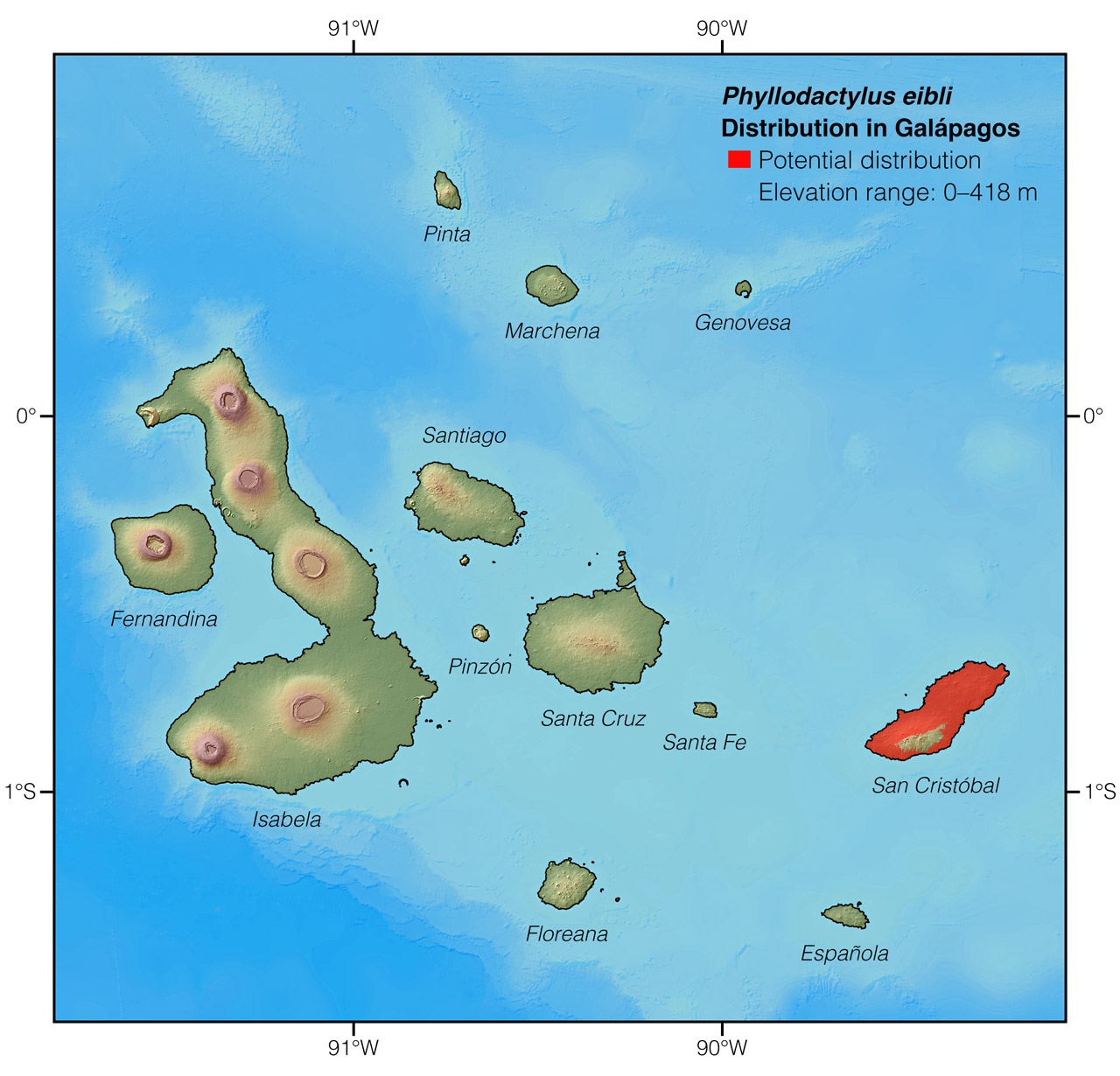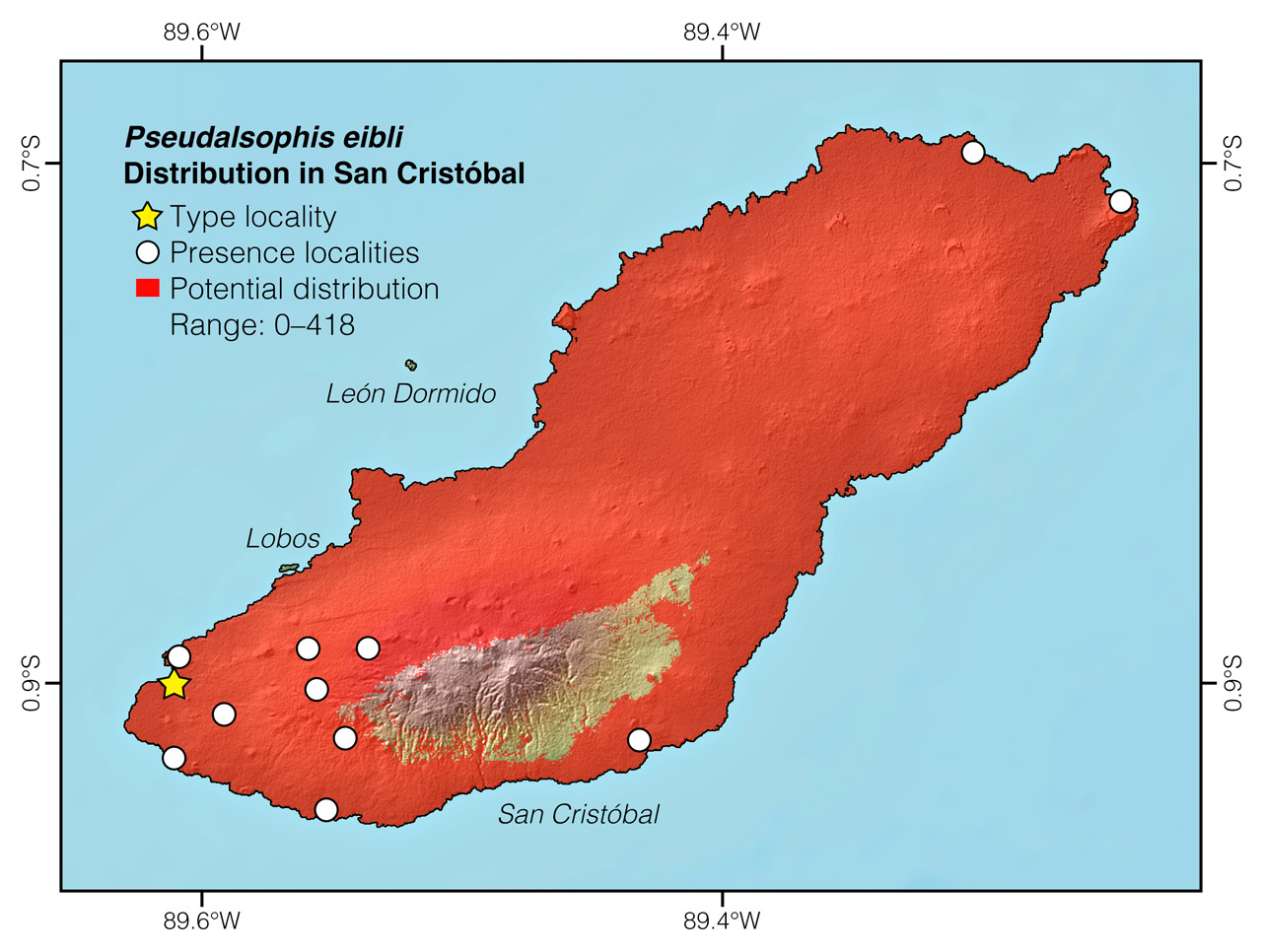Published May 26, 2024. Open access.
Eastern Galápagos Racer (Pseudalsophis eibli)
Reptiles of Ecuador | Serpentes | Colubridae | Pseudalsophis eibli
English common name: Eastern Galápagos Racer.
Spanish common name: Culebra oriental de Galápagos.
Recognition: ♂♂ 117.4 cmMaximum distance from the snout to the tip of the tail. Snout–vent length=83.4 cm. ♀♀ 89.2 cmMaximum distance from the snout to the tip of the tail. Snout–vent length=65.0 cm..1 Pseudalsophis eibli is the only terrestrial snake known to occur on San Cristóbal Island in Galápagos.1–4 It is characterized by having a pale grayish-brown dorsum with a series of light and dark longitudinal stripes (Fig. 1). This pattern differentiates it from the spotted P. biserialis, with which it was previously considered conspecific.2–5 The males of P. eibli differ from females by having a proportionally longer tail.1

Figure 1: Individuals of Pseudalsophis eibli from Cerro Tijeretas, San Cristóbal Island, Galápagos.
Natural history: Pseudalsophis eibli is a diurnal and terrestrial snake that inhabits coastal volcanic rock areas, dry shrublands, dry grasslands, and seasonally dry forests, with individuals occasionally venturing into agricultural fields.3,6 During daytime, these snakes are typically seen swiftly moving at ground level,2,6 but arboreal behavior has also been recorded.7 Galápagos racer snakes in general are mildly venomous, which means they are dangerous to small prey, but not to humans.1,2 The diet in P. eibli includes geckos (Hemidactylus frenatus, Gonatodes caudiscutatus, and Phyllodactylus leei), lava lizards (Microlophus bivittatus), juveniles of the Marine Iguana (Amblyrhynchus cristatus), invertebrates, and birds.3 There are recorded instances of predation on individuals of this species, including by native (owls, mockingbirds, herons, anis, and centipedes) and exotic (dogs, cats, rats, and chickens) predators.3
Conservation: Near Threatened Not currently at risk of extinction, but requires some level of management to maintain healthy populations.. Pseudalsophis eibli is a recently revalidated species.3 Therefore, it has not been formally evaluated by the IUCN Red List. Here, it is provisionally assigned to the NT category because new evidence suggests that this species is entirely restricted to San Cristóbal Island, the second most populated island of the Galápagos, and its population densities have declined in recent years following intense predation by invasive species.3
Distribution: Pseudalsophis eibli is endemic to an area of approximately 496 km2 in San Cristóbal Island, Galápagos, Ecuador (Figs 2, 3).

Figure 2: Distribution of Pseudalsophis eibli in Galápagos.

Figure 3: Distribution of Pseudalsophis eibli in San Cristóbal Island. See Appendix 1 for a complete list of the presence localities included in the map.
Etymology: The generic name Pseudalsophis comes from the Greek words pseudo (=false) and Alsophis (a genus of Caribbean snakes), referring to the similarity between snakes of the two genera.1 The specific epithet eibli honors Austrian ethologist Dr. Irenäus Eibl-Eibesfeldt (1928–2018) of the Max Planck Society, who collected the holotype.5
See it in the wild: The Eastern Galápagos Racer is not a common species, but it can be seen at a rate of about once every few days on some tourism sites in San Cristóbal Island, such as the trail leading from Puerto Baquerizo Moreno to Playa Carola.
Author and photographer: Alejandro ArteagaaAffiliation: Fundación Khamai, Reserva Arlequín, Ecoruta Paseo del Quinde km 56, Santa Rosa de Mindo, Pichincha 171202, Ecuador.
How to cite? Arteaga A (2024) Eastern Galápagos Racer (Pseudalsophis eibli). In: Arteaga A, Bustamante L, Vieira J (Eds) Reptiles of Ecuador: Life in the middle of the world. Available from: www.reptilesofecuador.com. DOI: 10.47051/WSZB9865
Literature cited:
- Zaher H, Yánez-Muñoz MH, Rodrigues MT, Graboski R, Machado FA, Altamirano-Benavides M, Bonatto SL, Grazziotin FG (2018) Origin and hidden diversity within the poorly known Galápagos snake radiation (Serpentes: Dipsadidae). Systematics and Biodiversity 16: 614–642. DOI: 10.1080/14772000.2018.1478910
- Arteaga A, Bustamante L, Vieira J, Tapia W, Guayasamin JM (2019) Reptiles of the Galápagos: life on the Enchanted Islands. Tropical Herping, Quito, 208 pp. DOI: 10.47051/AQJU7348
- Cisneros-Heredia DF, Reyes-Puig C (2023) Natural history and conservation of the Galápagos snake radiation. In: Lillywhite HB, Martins M (Eds) Islands and snakes. Oxford University Press, 158–182. DOI: 10.1093/oso/9780197641521.003.0009
- Thomas RA (1997) Galápagos terrestrial snakes: biogeography and systematics. Herpetological Natural History 5: 19–40.
- Mertens R (1960) Über die Schlangen der Galapagos Inseln. Senckenbergiana biologica 41:133–141.
- Field notes, Reptiles of Ecuador book project.
- Photo by Francis Pollak.
Appendix 1: Locality data used to create the distribution map of Pseudalsophis eibli in Ecuador (Fig. 2). Go to the section on symbols and abbreviations for a list of acronyms used.
| Country | Province | Locality | Source |
| Ecuador | Galápagos | El Progreso | Torres & Mena 2018 |
| Ecuador | Galápagos | El Progreso, 1.6 km N of | iNaturalist; photo examined |
| Ecuador | Galápagos | El Progreso, 2 km SE of | Cisneros-Heredia & Reyes-Puig 2023 |
| Ecuador | Galápagos | Hacienda La Tranquila | iNaturalist; photo examined |
| Ecuador | Galápagos | Jardín de las Opuntias | iNaturalist; photo examined |
| Ecuador | Galápagos | La Candelaria | Cisneros-Heredia & Reyes-Puig 2023 |
| Ecuador | Galápagos | Lobería | Arteaga et al. 2019 |
| Ecuador | Galápagos | Path to Playa Carola | Arteaga et al. 2019 |
| Ecuador | Galápagos | Playa La Galapaguera | iNaturalist; photo examined |
| Ecuador | Galápagos | Puerto Chino (Freshwater bay) | Cisneros-Heredia & Reyes-Puig 2023 |
| Ecuador | Galápagos | Punta Pitt | Arteaga et al. 2019 |
| Ecuador | Galápagos | Wreck Bay* | Mertens 1960 |